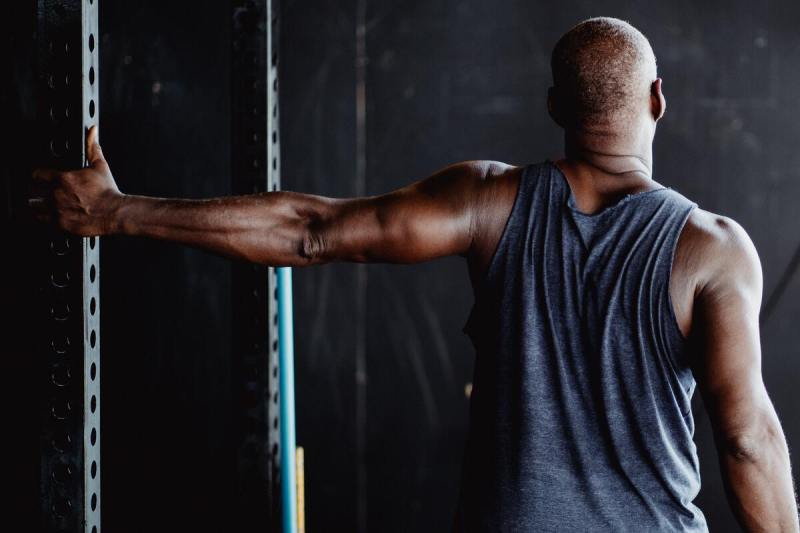
It’s very common to see tight shoulder muscles and shoulder injuries resulting from physical activity. However, this isn’t always due to the type of activity you engage in, but rather the lack of stretching. Stretches are often skipped, but are needed to maximize flexibility during the workout, as well as maximize your rest and recovery time.
Adding a shoulder stretch to your warm-up would improve your workout experience, as well as protect you from wear and tear. You’ll see your muscles loosen up and become stronger, with better endurance for your regimen. All you need are five great shoulder stretches to do before and between reps to increase strength without the strain.

Signs you have tight shoulders
Aches and pains are tell-tale signs of shoulder tightness. In some cases, you may notice migraines and neck pain accompanying tight shoulder muscles because of the association of the trigeminal-cervical complex. It may feel that shoulder function comes and goes at unpredictable times, often with no control, leaving you to wait for the pain to subside.
If you experience uncomfortable sleep positions or have discomfort while driving or cooking, this may be your tightened muscles calling out for help. Additionally, many people have experiences with frozen shoulders, which can be characterized by fluctuating feelings of pain and lack of function. The joints are plagued by decreased motion and increased stiffness, and eventually, the ailment resolves.

What causes tight shoulders?
Daily strain
Many day-to-day activities can burden our shoulder muscles, and we don’t give it much thought until the aches creep up on us. Many of us are guilty of sitting hunched over a desk or phone, but slouching and overloading our shoulders with a lot of weight can put pressure and strain on the muscles. Slouching and standing with poor posture, or sitting with an unsupported back, as well as carrying too many bags up the stairs, are ordinary things that we do, but it leads to overworked and damaged muscles.
Chronic stress
Muscle tension in the shoulders is a typical reflex response to stressors attacking the body. When we feel stressed, our muscles become tense, eventually relaxing as we relieve our stress. However, if this evolves into chronic stress, the muscles will remain in a constant state of tightness and can even influence stress-related conditions.
Underlying conditions such as osteoarthritis, gout, and lupus contribute to the tightening of muscles. These are each a type of infection or inflammatory arthritis that influence joint pain and stiffness, thus contributing to tightened muscles within your shoulder.
Injury
Shoulder injuries happen more often than we think and are responsible for increased pain and decreased motion. This may be the case if you’ve dislocated your shoulder, suffered a fracture, or experienced some other direct trauma. Sports-related injuries may occur for individuals playing overhead sports like tennis and volleyball and can result in a reduced range of motion.
These function-limiting incidents may include a rotator cuff injury or biceps tendinopathy in which the tendon is ruptured due to lifting and overhead reaching. Muscle tension and injury may also be the product of improper form during workouts.

5 stretches for tight shoulders
1. Modified sleeper stretch
The modified sleeper stretch can help to reduce pain and tightness in the joints. Ultimately this stretch can enhance the mobility of your shoulder. It’s specifically effective in targeting posterior shoulder muscle injuries, like subacromial impingement syndrome, known commonly as Swimmer’s Shoulder.
Instructions:
- Lie down on the side that needs to be stretched.
- Flex your elbow out 90 degrees while elevating your shoulder to 90 degrees.
- Your trunk is to be rolled 20 to 30 degrees back to achieve internal rotation in the scapular plane.
- Ease your stretched shoulder into internal rotation through the end range of motion. This allows some resistance in your stretch.
- Use the non-stretched hand to push the stretched shoulder into internal rotation, applying pressure at the wrist joint. You should feel mild discomfort at this stretch.
2. Cross-body stretch
The cross-body stretch is another stretch that will help to release the tightness of your shoulder muscles. This versatile stretch can be done as a part of your morning routine, or you can do it standing up in your work office. The cross-body stretch can be done multiple times throughout the day in any location.
Instructions:
- You can do this stretch in a seated position without a back rest, or it can be done standing upright.
- Extend your arm laterally across your body while giving support to your elbow with the opposing hand.
- Do not allow your arm to rise higher than your shoulder.
- Maintain this stretch for 20 seconds and repeat it a few times. Give a 10-second rest period after each stretch.
- You can follow up by switching sides and repeating.
3. Pendulum stretch
The pendulum stretch is a popular rehabilitation exercise. With this shoulder stretch, you can work to strengthen the everyday movements of your shoulder and arm. This will be especially helpful for targeting the impacted arm in the event of an injury or direct insult.
Instructions:
- Begin in a standing position. Have a steady surface nearby for support.
- Allow your impacted arm to hang downwards as you lean forward slightly. If necessary, you can place the opposite hand on top of your sturdy surface to maintain support.
- With a straightened spine and relaxed shoulders, slightly bend your knees.
- Move your hanging arm backward and forward in a gentle motion.
- After this, you’ll move the arm from side to side in both directions.
- Follow up by moving your arm in circular motions.
- Do all three types of motion for ten reps.
- Follow up by repeating these motions on the opposite arm.
4. Cat-cow pose
When discovering how to stretch shoulder blade muscles safely and effectively, you’ll want to make sure you engage your traps. We rely on the trapezius muscle to elevate our shoulders and rotate our shoulder blades. The cat-cow stretch is advantageous for improving circulation in your neck, shoulders, and back.
Instructions:
- Position yourself on all fours as if you’re on a tabletop.
- Make sure your hands align directly underneath your shoulders while your knees and hips correspond directly.
- As you breathe in, tuck your chin into your chest. Roll your spine and shoulders upward in the manner of a cat.
- As you breathe out, raise your head slowly. While looking up, open your chest and arch your back in a downward position in the manner of a cow.
- Repeat as needed.
5. Letter T raises
Doing Letter T raises are also good for the trapezius muscle and upper back. This stretch has many benefits, as it helps to improve posture and alleviate carpal tunnel syndrome. Carpal tunnel syndrome is a condition that is often associated with hunching at a computer and improper posture, just like tightened shoulder muscles.
Instructions:
- Lie down on your stomach, resting your forehead on a pillow or towel.
- Form a T shape by spreading your arms out on either side of your body.
- Keep your elbows straight and squeeze your upper back muscles to raise your arms from the ground.
- Slowly bring your arms back down.
- Continue with two to three sets of 20 reps.



